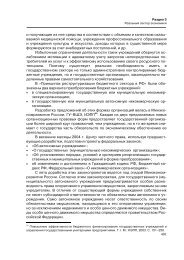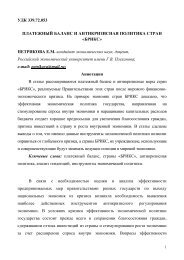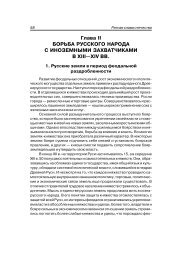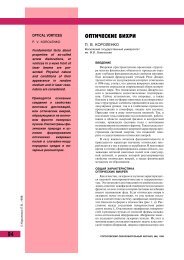Ensuring Strategic Stability in the Past and Present:
Ensuring Strategic Stability in the Past and Present:
Ensuring Strategic Stability in the Past and Present:
Create successful ePaper yourself
Turn your PDF publications into a flip-book with our unique Google optimized e-Paper software.
From time to time, <strong>the</strong> UK faces strong domestic movements for ab<strong>and</strong>onment of that country’snuclear status <strong>and</strong> nuclear deterrents. The primary reason for that is <strong>the</strong> fact that a considerablepart of British society sees no sense <strong>in</strong> <strong>the</strong> country hav<strong>in</strong>g its own SNF when British militarypolicy, <strong>in</strong>clud<strong>in</strong>g nuclear policy, is so l<strong>in</strong>ked to <strong>the</strong> United States.Charles de Gaulle <strong>and</strong> his associates, with <strong>the</strong> participation of Frederic Joliot-Curie, a dist<strong>in</strong>guishedphysicist <strong>and</strong> member of <strong>the</strong> French Communist Party, developed France’s nuclear forces<strong>in</strong> defiance of <strong>the</strong> positions of <strong>the</strong> United States <strong>and</strong> Great Brita<strong>in</strong>. France had commenced <strong>the</strong>implementation of a program aimed at <strong>the</strong> development of its own nuclear weapons <strong>in</strong> 1945, but<strong>the</strong> breakthrough <strong>in</strong> implementation was made only <strong>in</strong> 1958, when de Gaulle came to power.Accord<strong>in</strong>g to a number of estimates, France has spent three to four times more money than <strong>the</strong>United K<strong>in</strong>gdom to establish an <strong>in</strong>dependent nuclear force. This is <strong>the</strong> price that <strong>the</strong> French nationdecided to pay for <strong>the</strong> relatively high degree of <strong>in</strong>dependence enjoyed by its nuclear deterrentforces.It was also de Gaulle who established France’s missile <strong>in</strong>dustry, which was very much unwelcomedby <strong>the</strong> United States, <strong>and</strong> <strong>the</strong>n France’s own electronic eng<strong>in</strong>eer<strong>in</strong>g <strong>in</strong>dustry <strong>and</strong> manyo<strong>the</strong>r th<strong>in</strong>gs. This was all a manifestation of France’s national spirit, because its nuclear forces didnot have <strong>and</strong> still do not have a large military significance. France needed to have its own SNF tov<strong>in</strong>dicate its status as a superpower, especially after it lost its colonies, first of all Algeria. Presidentde Gaulle developed <strong>the</strong> nation’s nuclear forces largely <strong>in</strong> order to compensate for that loss, whichwas very pa<strong>in</strong>ful for France. Hav<strong>in</strong>g developed France’s own weapons, de Gaulle withdrew from<strong>the</strong> NATO military comm<strong>and</strong> <strong>in</strong> 1967, made a st<strong>and</strong> aga<strong>in</strong>st <strong>the</strong> location of <strong>the</strong> NATO headquarters<strong>in</strong> Paris, <strong>and</strong> expelled 30,000 employees of this organization from France.France ma<strong>in</strong>ta<strong>in</strong>s its operationally ready arsenal of about 350 nuclear warheads designated fordelivery by SLBMs, carrier-based <strong>and</strong> l<strong>and</strong>-based strike aircraft. 108The basis of France’s nuclear deterrent forces is <strong>the</strong> <strong>Strategic</strong> Oceanic Force, which has four operationallyready SSBNs that are pr<strong>in</strong>cipally capable of operat<strong>in</strong>g <strong>in</strong> any region of <strong>the</strong> world’s oceans.This seago<strong>in</strong>g force <strong>in</strong>cludes three new Triomphant-class submar<strong>in</strong>es, <strong>and</strong> one L’Inflexible-class(formerly Redoutable-class) submar<strong>in</strong>e. The latter (L’Inflexible-class SSBN) was to be removedfrom operational status <strong>in</strong> 2010, when <strong>the</strong> fourth <strong>and</strong> <strong>the</strong> last Triomphant-class SSBN—Le Terrible—wasscheduled to be commissioned. The French SSBNs are armed with 16 AerospatialeM45 SLBMs (each missile carries up to 6 warheads). In 2010–2015, start<strong>in</strong>g with Le Terrible, <strong>the</strong>Triomphant-class submar<strong>in</strong>es are be<strong>in</strong>g upgraded to M51.1 SLBMs with a longer range. The newmissiles will carry up to six warheads, <strong>and</strong> <strong>the</strong>ir maximum range will be 8,000 km (<strong>the</strong> estimatedrange of M45 missiles was 4,000 km). 109 Thus, <strong>the</strong> French SNF are able to provide for <strong>the</strong>“tous azimuts” deterrence that was postulated by de Gaullists <strong>in</strong> <strong>the</strong> beg<strong>in</strong>n<strong>in</strong>g of <strong>the</strong> 1960s.The French nuclear forces will rema<strong>in</strong> <strong>in</strong>dependent of <strong>the</strong> United States after France, <strong>in</strong> conformitywith <strong>the</strong> decision of President Nicolas Sarkozy, fully returns to <strong>the</strong> NATO fold from whichde Gaulle withdrew <strong>in</strong> <strong>the</strong> 1960s. In March 2008, Sarkozy promised that France “could <strong>and</strong> shouldbe more transparent with respect to its nuclear arsenal than anyone ever has been.” 11054<strong>Ensur<strong>in</strong>g</strong> <strong>Strategic</strong> <strong>Stability</strong> <strong>in</strong> <strong>the</strong> <strong>Past</strong> <strong>and</strong> <strong>Present</strong>: Theoretical <strong>and</strong> Applied Questions
















